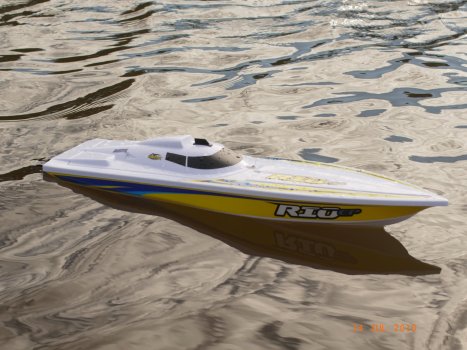
 This really is like Xmas – we have just been sent four top RC boats for review. The other two RC models, soon to be reviewed on this site, are the Aquacraft Semi Pro model Supervee27 and the Semi Pro model Joysway Surge Crusher – but we will do these separately…
This really is like Xmas – we have just been sent four top RC boats for review. The other two RC models, soon to be reviewed on this site, are the Aquacraft Semi Pro model Supervee27 and the Semi Pro model Joysway Surge Crusher – but we will do these separately…
These last two Semi Pro models are reputed to produce staggering speeds in excess of 45km/hr. So let’s check out the first two stages: (1) play-thing stage and then the (2) getting a bit more serious stage.
So stay with us as we initially check out the Aquacraft Mini Thunder and the Aquacraft Rio EP!

 All of these Aquacraft RC boats have been supplied by www.hobbygear.com.au with the Mini Thunder being the smaller of the two crafts.
All of these Aquacraft RC boats have been supplied by www.hobbygear.com.au with the Mini Thunder being the smaller of the two crafts.
Consult the specifications listed below and you will see that the Mini Thunder is a fairly small boat mainly suitable for ponds, swimming pools and perhaps a small lake or river, where the waves aren’t too high. The Rio EP, on the other hand, has the length to handle a taller wave height.
Mini Thunder – Features
Durable, lightweight ABS construction
380 water-cooled motor
2-channel FM radio system
Waterproof ESC and receiver
7.2V 1100mAh 6-cell NiMH battery pack w/12V field charger
Boat stand included
380-size water-cooled motor
Electronic speed control
1100mAh NiMH battery
12V DC peak charger
Pre-applied decals
Note: With the Mini Thunder you get everything needed to go boating!
Rio EP – Features
Offshore super boat styling with a factory-applied trim scheme
Durable, lightweight ABS construction
Tactic™ 2.4GHz pistol-grip radio system with SLT™ – Secure Link Technology
Dual break-away aluminium rudder system to protect transom
Surface Drive system for enhanced control and performance
1/8” flex cable and prop shaft
550-sized water-cooled motor
Aluminium trim plates allow fine-tuning for maximum performance
Sealed, waterproof ESC and Receiver
Built-in drain plug
Boat stand
Note: With the RIO EP, a roll of sealing tape and a spare propeller are included, but you will also need a charger and batteries.
SPECIFICATIONS: – Mini Thunder
Length: 17.5 in (444 mm)
Width: 8 in (203 mm)
Height: 5 in (126mm)
RTR Weight: 18.4 oz (522 g)
Motor: AquaCraft 380 water-cooled motor (included)
Radio: AquaCraft 2-channel FM radio (included)
Requires: (8) "AA" batteries for the transmitter
SPECIFICATIONS: – Rio EP
Hull Length: 25.5 in (647 mm)
Overall Length: 28.3 in (720 mm)
Beam: 6.4 in (160 mm)
Weight: 26.4 oz (750 g)
Height: 5 in (125 mm)
Requires: 6- or 7-cell NiCd/NiMH battery, charger and 4 "AA" batteries suggested 3000 mAh NiMH
Transmitters

 Mini Thunder
Mini Thunder
2-channel FM radio
Converts easily for left- or right-hand use
Proportional throttle and steering
Audible low battery alarm
Steering trim control knob
Rio EP
TTX240 2.4GHz Radio System
Provides precise, reliable, interference-free control. Includes a factory-installed receiver, servo and ESC.
The Rio EP has a 2.4 GHz so it gets full marks for this as this frequency usually performs consistently. Note that this boat is capable of reverse movement.
Assembly
We really couldn’t fault either of these crafts for the assembly time, as apart from pushing an aerial into the Mini Thunder and charging batteries, it was ready to go. The Rio EP was even faster as its antenna is inbuilt into the craft. This is something we really liked and should be copied into all of their models.
Because “bigger is better”, we asked HEI Hobby Express International for some better batteries than listed and we were immediately offered an Itellect NiMH 7.2 volt 5000mAh for the Rio EP (maximum size that will fit) and a 1600 mAh NiMH for the Mini Thunder (maximum that will fit).
Build Quality and Aesthetics
The Mini Thunder looks great and is a very simply constructed unit.
The Rio EP looked excellent and the ONLY fault we could find was a couple of air bubbles under transfers which we had to prick with a needle to achieve a high quality finish.
Both came with some additionally supplied transfers so they could be cosmetically enhanced if desired.


We also liked the clean and simple mechanics of both boats. Particularly with the Rio EP being exceptionally well set out, easy to dry out and very easy battery insertion and removal.
Manual
The manual for the Rio EP says nothing of real value about what you can do or can’t do with regard to batteries. Not that this is a big deal as it’s usually the last thing people read and once you’ve read it you don’t really need it again. But it is of some concern that they don’t say that this is a brushed motor, which leaves you guessing a bit. Anyway, you can put a 6-7 cell NiMh @1.2volt per cell in i.e. = 8.4 volts or a 2 cell Lipo @ 3.7 volt per cell i.e. + 7.4 volts.
Li Po will be quicker but you will do terminal damage to the Li Po battery if you drive it until the motor stops, as the Li Po will be too flat to recover as there is no ESC is in there for early protection cut off.
TX
The Mini Thunder has a Aquacraft FM transmitter which worked fine without any hitches during all the tests. I still don’t like any TX’s that are FM or AM as they are prone to failure from interference at the wrong time. Nevertheless, some are superior to others. A temporary glitch, however, is not really so bad with this little boat though, so don’t let it put you off as it’s not doing 80km/hr and if interference does occur, it usually is only for a second or two.
The Rio EP has a 2.4 GHz so it gets full marks for this, as it always performs consistently faultless.


The little Mini Thunder seemed pretty comfortable in the conditions shown and did not take on any water whatsoever, it was easy to control, had long battery times and all in all, performed better than we expected of such a small boat. Top speed was 18.5 km per hour.
The Rio EP certainly was a class up, and had absolutely no trouble in handling the conditions we had it on. It surprised us with its problem free turning ability and at no time was it in danger of being flipped. It attained a top speed of 18.8 km per hour and had a battery time of approx 25 minutes on a 3000 mAh Ni Mh battery.
The RIO EP looks great and performed consistently well with an even acceleration speed up to and including getting on plane, making it perfect for anyone really who wants a nice even and predictable drive around the waters. Being considerably longer than the Mini Thunder, it had no problems in the slightly rough conditions we tested it in.


Conclusions
We established that the Mini Thunder to be excellent as a small inexpensive RC toy that the kids could have fun with in a swimming pool, pond or such like where they could race each other without getting into trouble.
We noticed the Rio EP was far more serious about having potential for more speed upgrades, looks and handling which we say it accomplishes all three extremely well. This boat gets attention and a hobby enthusiast could race it across far rougher water conditions than expected with reliability of 2.4 GHz control, so you should not have to ever go in the water to retrieve it.
Something that was totally unexpected was that it had reverse movement capability.
We found both boats a fair price for the money you have paid Thunder RRP $179 and RIO $399 but our personal recommendation at this point in the reviews is to pay the extra and purchase the Rio as it’s more versatile for small and large bodies of water and you could pinch it off the kids.



